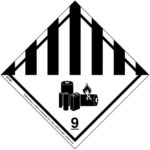Question received March 26, 2018:
Mr Stoehr,
I was doing some research when I came across your website and had a question on the requirement for a Class 9 placard on an international vessel shipment via CTU (Cargo Transport Unit, a type of freight container) on the following:
- UN3480, Lithium Ion Batteries, 9, II – (21kg. net) 23 kg. Gross
- UN3090, Lithium Metal Batteries, 9, ll – (14 kg. net) 34.45 kg. Gross
- Lithium ion battery
- Lithium metal battery
I’m familiar with 49 CFR 172.504(f)(9) for no placard required for domestic shipping. Just not clear on international shipments via vessel.
Thank you very much for your time Sir have a great day.
My reply with a partial answer the next day:
I have a partial answer for you now but can provide a more complete answer if you are able to provide more information about your shipment. Please see below.
- With a few exceptions the International Maritime Organization Dangerous Goods Code (IMDG Code) requires enlarged labels (placards) to be displayed on a cargo transport unit (CTU) for any primary and subsidiary hazard of the dangerous goods contained within.
- As you indicate, the domestic regulations of USDOT/PHMSA do not require display of the Class 9 placard within the U.S. There is no such exception in the international regulations.
- Therefore, under some circumstances this would require the display of the Class 9 placard on all four sides of the CTU.
- However, special provision 188 allows for an exception from most of the IMDG Code for lithium batteries of a certain size. To determine the applicability of this regulation please provide the following:
- Watt-hour (Wh) rating of lithium ion batteries
- Lithium metal content (g) of lithium metal batteries.
| Status | Lithium Ion Battery (Watt-hour (Wh) Rating) | Lithium Metal Battery (Lithium Content (g)) |
||
|---|---|---|---|---|
| Battery | Cell | Battery | Cell | |
| Subject to "smaller battery exception" | Does not exceed 100 Wh | Does not exceed 20 Wh | Does not exceed 2 g | Does not exceed 1 g |
| Subject to full regulation | Exceeds 100 Wh | Exceeds 20 Wh | Exceeds 2 g | Exceeds 1 g |
| Subject to "smaller battery exception" by highway or rail | Does not exceed 300 Wh | Does not exceed 60 Wh | Does not exceed 25 g | Does not exceed 5 g |
I’m happy to help you further.
|
Contact me the next time your USDOT, IATA (air), or IMO (vessel) training is due to expire. |
A long while later (May 1st!) I hadn’t hear from him so I followed up:
Please let me know if my answer was satisfactory or if you require further information.
I am happy to assist you!
And he came right back:
Thank you for your response very much appreciated. The total Watt Hours exceeded the limit. So I ended up putting a UN3480 class 9 placard on thank you for your assistance.
|
Like this article? Subscribe to my Monthly Newsletter No marketing emails! |
Conclusion:
Looking at his answer now, I’m concerned by the wording of his response, “The total Watt Hours exceeded the limit”. “…total…”? My concern is that he might have tallied up the Watt hour (Wh) rating for every lithium ion battery in the consignment. He then may have found this total then exceeded the limit – actually a threshold – between a fully-regulated lithium battery and one subject to the packaging exception identified in Special Provision 188. A lithium battery (ion or metal) below the threshold value is not subject to full regulation in the IMDG Code and does not require the display of the Class 9 Lithium Battery label on the package nor the Class 9 Miscellaneous placard on the CTU. A fully-regulated lithium battery, however, does require the display of the Class 9 Lithium Battery label on the package and the Class 9 Miscellaneous placard on the CTU. And a lot more.
- Class 9 Lithium Battery label
- Class 9 Miscellaneous placard
The questioner indicated he is aware of the differing regulatory requirements for the display of the Class 9 Miscellaneous placard: required for international transportation v. not required – but allowed for domestic transportation. In this situation the CTU may – or may not – display the Class 9 Miscellaneous placard when transported within the U.S., but once it is prepared for international transportation by vessel, i.e., at the dock, it must display the Class 9 Miscellaneous placard.
The regulations for the transportation of a hazardous material can be complicated. Let me help you to navigate through them. My training can give you the knowledge necessary to access the regulations and find these answers for yourself. And, of course, you can always contact me for help.
|
Daniels Training Services, Inc. 815.821.1550 |




